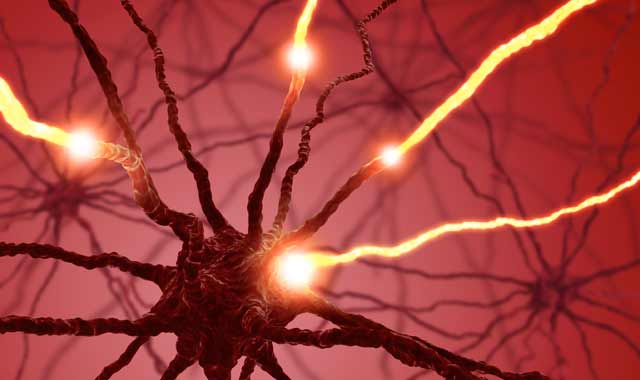Neurological diseases can hit any one at any time, sometimes with little warning. Here’s what you need to know about diagnosing and treating some of the most common disorders of the nervous system.

They often strike like lightning. Predicting when, where and to whom a neurological disease will hit is nearly impossible. Most are not curable, and are treatable only on a symptom-by-symptom basis.
Thousands of nerve-related diseases exist, from pinched nerves, carpal tunnel syndrome, migraine headaches and back pain to life-changing degenerative disorders.
By comparing a home’s electrical system to the human nervous system, we begin to understand what happens when a neurological disease strikes. The master switch box (brain) is the source of electrical power that flows through conduits to every part of the house. When a fuse blows, wires cross, or the coating on electrical wires wears thin, short-circuits occur. Similar events happen within the body, but are much more difficult to pinpoint, because neurological symptoms are easily confused with other problems.
When symptoms such as weakness, double vision, tremors, loss of motor control and even mood swings lead to a diagnosis of a neurological disease, nothing in the life of a patient, family, friends or coworkers is the same.
Donna Pacholski is the clinical lead nurse in the ambulatory care and pain clinic at Advocate Good Shepherd Hospital in Barrington. She sees patients with multiple sclerosis (MS) and myasthenia gravis (MG) on a daily basis and explains that both conditions are treatable but not curable.
“The patients we treat are considered chronic but not acute,” Pacholski says. “They can live at home, as opposed to those with acute forms who need hospitalization. Some we have treated for many years.”
MS often strikes young adults in their late 20s, but patients can be diagnosed as late as in their 60s. Patients don’t die from MS, but rather from pneumonia and other sicknesses that result from the disease’s effects on the nervous system.
The Multiple Sclerosis Association of America describes MS as the most common neurological disease diagnosed in young adults. While it can’t be prevented or cured, treatments are available which reduce its severity and slow its progress. Its effects differ with each patient. Some have a flare-up and then remission – lasting for months or years – while others experience a steady progression. The association estimates there are 400,000 Americans with MS, and around 10,000 more are diagnosed each year.
“Our patients at Advocate are mostly treated on a monthly basis, with infusion medications and steroids,” Pacholski says. “When they have flare-ups, they come in for intensive treatment that can last three to five days, or as much as is needed to quiet the flare.”
Dr. Mohamed Ghumra, a board-certified neurologist who practices at Sherman Hospital in Elgin, says exciting breakthroughs in MS treatment have been made over the past 15 years. This autoimmune disease results in plaques, or “scarring,” seen as lesions on MRI studies. These inflammatory responses target the nerve coverings, which provide protections similar to the insulation on cable wires. How MS affects each patient depends on where, and to what extent, the lesions occur.
“MS can influence balance, cause weakness or numbness, damage the spinal cord, cause bladder or bowel problems, and cause other symptoms,” Ghumra says. “Unfortunately, in the past, MS has been treated with injected medications on a daily, weekly or monthly basis, or through IV infusion. But recently, researchers have begun to uncover the benefits of several oral medications that treat MS, with the hope of better tolerability and specificity at the targeted disease process and improved repair of the damaged nervous system.”
One of these oral medications, BG-12, has been in use throughout Europe for the past five years, with significant and safe results, Ghumra says. He believes this medication may soon be approved for use in the U.S.
Pacholski points out that the physical effects are only one part of the challenge MS patients face. Because this neurological disease is lifelong and begins early in adulthood, the emotional and financial toll on patients and families is just as hard to face as the disease itself.
“We offer social workers to help them at home if they don’t have that support available,” Pacholski says. “We counsel families and help them to connect with all the resources available in the community. And we have a chaplain on staff to help as well.”
Long-term diseases like MS often result in financial stress on top of the obvious health problems, she adds. MS disrupts their short- and long-term plans, depending on the way in which the individual is affected.
“If the husband develops MS, he may not be able to work,” Pacholski says. “The wife has to take over. And if it’s the wife who has MS, the husband may have to assume many of her usual tasks, especially if they have young children. We’re talking about huge changes and a lot they have to deal with. We’ve seen spouses leave, because they simply can’t handle the situation. Other spouses have been wonderful, always there through the treatment process sitting with the patient, holding his or her hand.”
While there is no cure, new medications are giving hope. One available through the TYSABRI TOUCH prescribing program prevents major flare-ups and stabilizes MS patients. It has a downside, though, Pacholski explains. A virus that can attack the brain is associated with using this medication, making it mandatory to monitor patients closely.
“Nearly every year, we have new drugs to help treat MS and MG,” she says. “My sister developed MS 35 years ago and died when she was in her 40s. Not much in the way of medication was available then. I believe that, if she had MS today, she would have lived a longer, more fulfilled life.”
Parkinson’s disease (PD) is another treatable neurological disorder. The National Parkinson’s Foundation estimates that between 50,000 and 60,000 Americans are diagnosed with PD each year, adding to the more than one million already affected. Because of its commonality, PD is listed as the 14th leading cause of death in the U.S. Its base cause appears to be a lack of dopamine, a naturally occurring neurochemical in the brain that helps to regulate movement and mood. Early onset symptoms can include loss of the sense of smell, smaller or cramped handwriting, tremors, sleep problems, flat affect (loss of normal facial expression) and changes in body posture such as hunching over.
Dr. Syed Munzir, a board-certified neurologist with privileges at Provena Saint Joseph Hospital in Elgin, says PD patients typically are treated with supplementary dopamine and an exercise program. While certain conditions indicate PD, it can mimic other disorders.
“One of the important steps in the management of Parkinson’s disease is patient education,” Munzir says. “Sometimes, it is too early in the disease’s progress to be absolutely certain when the patient will need medication.”
Fortunately, these medications have few adverse side effects and are tolerated fairly well. However, for some patients who are profoundly affected by PD, a surgical procedure called deep brain stimulation may be recommended.
“Not everyone is a good candidate for this procedure,” Munzir says. “In the Chicago area, there are some hospitals that offer it. The use of deep brain stimulation suppresses some motor impulses while it stimulates others. It’s a delicate balance.”
According to the Mayo Clinic, deep brain stimulation involves implanting electrodes deep within the brain, to the part that affects mood. A pacemaker-like device, placed under the skin in the upper chest and connected through a wire under the skin, controls electric impulses to the brain. The device, called a pulse generator, stimulates brain cells and chemicals to relieve depression. Deep brain stimulation has not been approved by the federal Food and Drug Administration, and is mostly used during test studies.
“We have made great strides in treating Parkinson’s disease with medications and surgical procedures through Sherman Hospital,” Ghumra says. “If you’ve seen the movie ‘Awakenings,’ you have an idea of what can be done. Newly developed medications help patients control movement while reducing symptoms. Deep brain stimulation, strategically placed within the brain, can help alleviate certain target symptoms.”
Advanced surgical procedures not only improve quality of life but also reduce the need for medications. Ghumra notes that there is intensive, ongoing research into medications designed to protect the brain from this accelerated, degenerative process, which happens in specific parts of the brain. For patients with PD, Munzir says, traditional treatment comes in the form of mediations and, at times, physical therapy.
As for fibromyalgia (FM), no one can quite explain why a patient develops this painful disorder. Most researchers believe that FM is the result of faulty regulation in the brain’s neurotransmitters, causing patients to react to pain with an unusual intensity.
According to the National Fibromyalgia Association, FM is characterized by chronic, widespread body pain, often combined with a constellation of symptoms such as extreme fatigue; sleep disturbances; sensitivity to touch, light and sound; and cognitive difficulties. Many individuals also experience a number of other symptoms and overlapping conditions, such as irritable bowel syndrome, lupus and arthritis. Munzir says recent breakthroughs in pain management medications have brought relief to FM patients at Provena.
“There’s really no answer as to why some people get FM,” Munzir says. “It doesn’t appear to be inherited, although people may be genetically susceptible.”
While researchers have made remarkable breakthroughs in the treatment of many neurological diseases, some have remained both a mystery and a challenge. For the patients who face a life altered by these life-threatening diseases, the reality is often not only painful but cruel.
Huntington’s disease (HD) is a heartbreaker. According to the Mayo Clinic, HD is an inherited disease that causes the progressive breakdown of nerve cells in the brain. HD has a broad impact on a person’s functional abilities and usually results in movement, cognitive and psychiatric disorders.
Most people with HD develop signs and symptoms by the time they reach the age of 40 or 50, but the onset of disease may be earlier or later in life. When disease onset begins before age 20, the condition is called juvenile HD. Earlier onset often results in a somewhat different presentation of symptoms and faster disease progression. Medications are available to help manage the symptoms of HD, but treatments can’t prevent the physical, mental and behavioral decline associated with the condition.
Muscular dystrophies (MD) are genetic disorders for which no effective treatment has yet been developed. Genetic counseling is provided to help couples make informed decisions before starting their families. Dozens of types of MD have been pinpointed, including Amyotrophic Lateral Sclerosis (ALS). The Muscular Dystrophy Association categorizes ALS as a disease of the parts of the nervous system that control voluntary muscle movement. In ALS, motor neurons (nerve cells that control muscle cells) are gradually lost. As these motor neurons are lost, the muscles they control become weak and then nonfunctional. In the U.S., ALS also is called Lou Gehrig’s disease, named for the Yankees baseball player who died of it in 1941. Physicist Stephen Hawking has had ALS for many years and now can only move his eyes.
“Adult treatment involves alleviating symptoms, depending on how each person is affected,” Ghumra explains. “This can involve rehabilitation with physical therapy, occupational therapy, and speech and cognitive therapy, addressing issues such as weakness, spasticity, mobility and transfer issues with appropriate assistance devices and medications.”
Although these conditions aren’t yet curable, modern medicine and technology contribute to a wide array of treatments that make life easier for those suffering from a neurological disorder.
“One good thing is the existence of excellent organizations that help patients through enrollment in studies, education and moral support,” Munzir says. “They not only help patients to cope with their respective diseases and promote advanced research into cures, but they also provide much-needed hope for a better, brighter tomorrow, not only for current patients but for future generations as well.”





















































